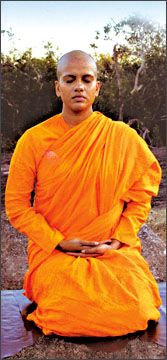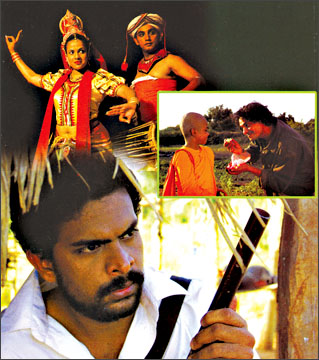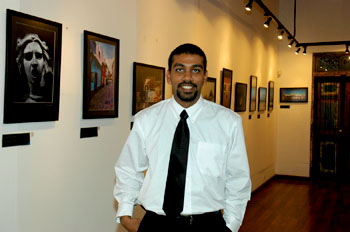Arts
Uppalavanna : A contemporary Theri-Gatha Sojourn in a nunnery
by Indeewara Thilakarathne and Ranga Chandrarathne
Uppalavanna, a film directed by Prof. Sunil Ariyaratne and produced
by Milina Sumathipala, is woven around an eventful life of a girl, Upuli
who entered the Buddhist order of nuns following the tragic events in
her life; the killing of her husband by her father at Upuli's mother's
funeral and subsequent imprisonment of her father.
 According to the pali cannon, Uppalavanna was the Buddhist nun famous
for her psychic powers. However, the contemporary Uppalavanna is
different in that she has, more or less, become the victim of the
circumstances. According to the pali cannon, Uppalavanna was the Buddhist nun famous
for her psychic powers. However, the contemporary Uppalavanna is
different in that she has, more or less, become the victim of the
circumstances.
The story unfolds with Upuli, a daughter of an aristocratic physician
father, falling in love with the son of her teacher of dancing and
marries her sweet heart against parent's wishes.
Upuli's mother dies after a prolonged illness apparently precipitated
by Upuli's out of caste marriage. On the day of the funeral, Upuli with
her husband visits the funeral and furious father (brilliantly portrayed
by Suminda Sirisena) kills Upuli's husband, thus changing her course of
life.
Stricken hard by the fate befallen on her, Upuli entered a Buddhist
nunnery with a firm resolve of committing herself to a hard life of
spiritual practice. However, the nunnery does not escape from tremors of
a social upheaval as the residual insurgents take refuge in the thick
forest surrounding the nunnery, to carry out their military operations.
Peaceful life in the nunnery is shattered when the villagers capture
the severely wounded insurgent from the nunnery premises. The insurgent
was the killer of the only undergraduate of the village. In the
subsequent inquiry conducted by the police, it was revealed that
Uppalavanna had treated the severely wounded insurgent.
With the revelation, angry villagers stopped offering alms to the
nunnery. The film ends on a note of a question mark over the fate of
Uppalavanna who decided to leave the nunnery.
Although the film is set against a pastoral village with impressive
nature-escapes, the film lacks depth in terms of evolution of characters
and overall message that it strives hard to convey.
It is quite incomprehensible whether the film maker intends to codify
the period of terror and the counter insurgency measures adopted by the
Government of the day or to highlight the rigid cast system which is
still prevalent , especially, among landed-gentry of the up-country.
 However, the period of terror has been depicted somewhat
authentically as the only undergraduate who was a former insurgent, had
been killed by an insurgent showing the brutal nature of hate-mongers
and hapless villagers sandwiched between Government rule and the degree
of the insurgents. However, the period of terror has been depicted somewhat
authentically as the only undergraduate who was a former insurgent, had
been killed by an insurgent showing the brutal nature of hate-mongers
and hapless villagers sandwiched between Government rule and the degree
of the insurgents.
Especially the dialogue was written in a way capturing the essence of
social injustice suffered by the youth and Tissa Abeysekara had written
those lines with a deep-understanding and insight of the issues faced by
the youth and unrest.
For the Characterisation, Suminda Sirisena as father of Upuli, Rohana
Beddage as Teacher of dancing and the character of the insurgent (Roshan
Ravindra) who killed the undergraduate, undergraduate (Jagath Chamila)
and Chandani Seneviratne have contributed to give a realistic dimension
to the otherwise, meaningless concoction of events; reminding some
scenes of Water and Sankara.
Although one may not be able to pinpoint that the film has copied or
rather adapted some scenes from Water or Sankara, it is doubtful whether
the film maker had attempted to adapt some elements of Water in a
Buddhist milieu.
Especially the character of Podi Atthi remind the viewers of Chuiya
in Water though it is not as lively as Chuiya.
Upuli and Uppalavanna portrayed by Sangeetha Weeraratne, is still not
able to come out of her over acting mode which is apparent from
induction ceremony into the nunnery as a novice.
However, veteran film maker and literatus Tissa Abeysekera should be
commended for the insightful dialogues which shed light to the film.
Malini Fonseka's long hair had hindered authenticity of that character
which demands a mature personality (not maturity in terms of graying
hair).
Malini's voice control is not at all suited for a matured nun and
another shortcoming is that a long period of time had been allocated for
the scene of shaving Upuli's hair. Here the editor has failed to prone
the scene to suit the film rather than reporting it.
Another scene which is prominently displayed was the swimming of the
severely wounded insurgent across the lake to the shore of the nunnery
with one hand being almost lost and with his intense bleeding and
wounds, the scene is far from being realistic.
Overall assessment the film lacks Aesthetic quality.
Navaratne Gamage's music, Camera by Suminda Weerasinghe and the vocal
chords of Nanda Malini have made a meaningful contribution to the film.
Dr. Praneeth Abeyasundera with his melodious wording has attempted to
capture the spirit of the tone of Buddhist chanting.
All in all, Uppalavanna falls into the category of artistic films for
which Prof. Sunil Ariyaratne should be praised as Sri Lanka needs more
and more artistic films in order to build an informed audience.
Sri Lankan viewers expect Prof. Sunil Ariyaratne who made a lasting
contribution to his field of study and to the artistic films, to make
more and more films either exploring the intricacies of human nature and
the socio-political changes and their impact on the society. The film is
produced by Milina Sumathipala on behalf of Sumathi Films.
[email protected]
'Sights and lights'
by Rajmi Manatunga
'A photograph is a secret about a secret. The more it tells you, the
less you know.' - Diane Arbus
'Sights & Lights: a journey through Cultures', a photographic
exhibition by Thishya Weragoda was held at the Gandhara Gallery
recently.
The maiden photographic exhibition by the young and upcoming artist,
it featured 45 colourful and engaging snapshots taken by him during his
student day travels in different parts of the world, mainly Europe.
 Among the colour prints that adorned the gallery walls from July 14
to 20 were photographs depicting the culture and way of life of several
countries including Sri Lanka, Egypt, Jordan, Czech Republic, Poland,
Hungary, Serbia, Netherlands, Belgium and France. Among the colour prints that adorned the gallery walls from July 14
to 20 were photographs depicting the culture and way of life of several
countries including Sri Lanka, Egypt, Jordan, Czech Republic, Poland,
Hungary, Serbia, Netherlands, Belgium and France.
The subjects of the artist ranged from intricate sculptures at the
Louvre museum, the colourful alleyways in Prague, a picturesque and calm
night view of the Danube, to a black and white print of a jovial
youngster in Belgrade trying her hands at steering a helm.
The photographs displayed the artist's ability to use the camera to
capture the essence of diverse societies and paint an unbiased tableau
of their respective cultures. His works based on Sri Lanka, portraying
the modest but profound facets of the local culture based on the
Buddhist philosophy, provided further proof to this effect.
They included a unique snapshot of a reflection of sunrise over a
paddy field at Kataragama, a sedate view of the Ruwanveliseya through
the branches of a tree, true to its title 'Serenity', and a cross
section view of the Sandakada Pahana at the Polonnaruwa Vatadageya
titled 'Sansara'.
His work comprised images of the both the everyday life as well as
the unusual in different cultures.
His photographs of human beings were spontaneous and refreshing. "I
decided to call the exhibition 'Sights & Lights' because the sights I
captured ware not only about the location I saw. I added colour to it by
using light, artificial or natural, to enhance the value and the mood of
the moment I captured," Weragoda said.
A lawyer and a CIMA Passed Finalist, photography has been his
favourite pastime since he clicked a few snapshots during a road trip in
the United Kingdom a few years back.
"Taking photographs was about trying to capture the moment at first
and then grew into a hobby. But during that road trip I took some
reasonably good shots using a very basic camera.
After that I decided that I am going to take my past time more
seriously and bought a SLR camera. Ever since, my camera has been a
consistent travel accessory along with my wallet and mobile phone".
According to Weragoda, the photos of 'Sights & Lights' were selected
from a 2 year collection of about 3000 photographs. Out of the 45
photographs that were on sale, over 30 were sold during the time of the
exhibition.
"I believe that the quality of the pictures I captured have developed
over the years. I have matured very much since I began taking photos and
learnt that it is all about timing and patience," he added.
'Sights and Lights' provided the viewer with a revealing photographic
cultural cross-section of the world. It was truly a feast for the eyes. |
